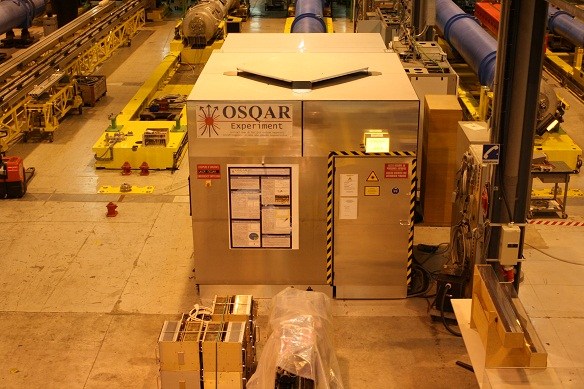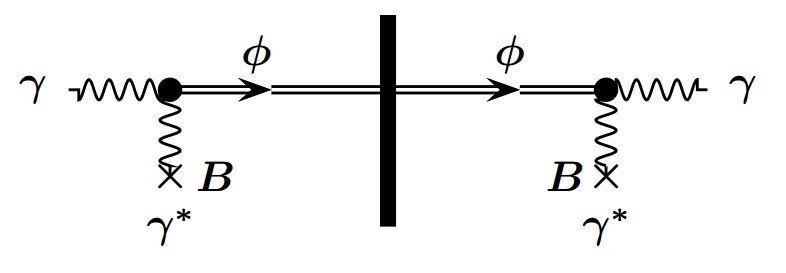OSQAR experiment sheds light on a hidden sector of CERN’s scientific heritage
Particle physics is not only confined to the high energy frontier. There are unexplored territories at ultra-low energies, of sub-eV to eV, which are also very promising, such as for example in dark matter (DM) searches. The emblematic particle of this physics is the axion, a pseudo-scalar particle predicted independently in 1978 by S. Weinberg [1] and F. Wilczek [2], to solve the fundamental problem of the apparent non-violation of the CP symmetry by the strong interaction (QCD) from the breaking of the Peccei and Quinn symmetry [3].
Standard axion with coupling at the electroweak scale, i.e. with a mass in the keV range, has been excluded after extensive searches in collider experiments. This has led the scientific community to consider the case of "almost" invisible axion, i.e. with a mass and coupling to other particles extremely weak. If the axion mass is in the range 10-6 to 10-2 eV, this particle could also be responsible for the DM of our universe and constitutes one of the rare non-supersymmetric candidates. On the other hand, various ultra-light and weakly interacting scalar and pseudo-scalar particles are naturally present in string theory without the need of solving the strong CP problem. This new family of particles has coined the name of WISPs for Weakly Interacting Slim Particles in complement to the WIMPs standing for Weakly Interacting Massive Particles. P. Sikivie showed in 1983 [4] that the invisible axion as well as axion like particles (ALPs), a subfamily of WISPs, could be detected via a chiral anomaly that modifies Maxwell's equations.
In this context, the two distinct OSQAR experiments at CERN (Fig.1), namely the OSQAR-LSW and OSQAR-VMB look mostly for ALPS through studies of optical properties of the quantum vacuum permeated by a strong magnetic field [5].More recently OSQAR has been extended with OSQAR-CHASE [6] in the search of chameleons, a special type of particle that could account for dark matter. The above mentioned experiments are based on an extensive use of spare LHC dipoles providing a magnetic field of 9 T over 14.3 m. OSQAR experiments are complementary to CAST [7], originally an helioscope searching axion and ALPs, which might be produced by the sun. It has been recently converted into haloscope to scrutinise the DM wind of our galactic halo crossing the Earth.
The title of this letter highlights the hidden sector of CERN’s scientific heritage since the first proposal to test the QED by measuring the vacuum magnetic birefringence was actually born at CERN in 1979 [8] with some very preliminary tests done in the early ‘80s. In addition, the possibility to detect nearly massless, spin-zero particles on light propagation in a magnetic field was first theoretically investigated at CERN in 1986 [9].

Fig.1: The OSQAR experiment at CERN installed in the SM18 hall with the laser protective area installed in front of a spare LHC dipole.
OSQAR-Light Shine through walls
The OSQAR-LSW experiment aims to detect ALPs from the light shining through wall experimental scheme [10] shown in Fig. 2. This type of experiment can be split in three main parts, one for the photon to axion conversion in strong magnetic field, a second one for the absorption of non-converted photons and the last part for the photon regeneration and detection.

Fig. 2: Principle of a LSW experiment within two vacuum chambers permeated by a strong transverse magnetic field and separated by an optical absorber.
The basic ingredient concerns the production of ALPs from a polarised laser beam in the background of a strong magnetic field through the Primakoff process γ γ* --> A. If ALPs are produced, they propagate freely along the same direction as the laser beam, cross the wall due their low coupling strength to matter before entering in the regeneration chamber located on the opposite side of the experiment. All photons not converted into ALPs in the first part of the experiment are absorbed by the wall inserted in between. A second external magnetic field applied within the regeneration area, allows the ALP to be reconverted into a photon via the inverse process A γ* --> γ before being subsequently detected.
Fig. 3: The OSQAR experiment in operation with the 20 W laser beam aligned within the second aperture of the LHC dipole (OSQAR-CHASE run, 21 July 2017).
Fig. 4: Exclusion plots for axion and axion-like particles as a function of the axion mass and the di-photon coupling constant (extracted from [12]). QCD axions are constrained within the yellow band by the two theoretical models KSVZ and DFSZ. Haloscopes are today the most sensitive experiments to detect QCD Axion from the inverse Primakoff effect assuming they are the main component of dark matter of our galactic halos. The CAST helioscope is sensitive to QCD axion in the eV range and ALPs produced within the sun independently on whether such particles are component or not of dark matter. LSW experiments such as OSQAR are today the less sensitive and their performance must be improved. They are the only ones requiring no additional hypothesis “of anthropic type” to be analyzed. The exclusion limit obtained by PVLAS from VMB measurement without reaching the QED prediction, is more sensitive at higher axion mass than OSQAR because of the shorter length of the magnets used.
The OSQAR-LSW experiment is installed in the SM18 hall at CERN (Fig. 1). For the last experimental run, a 20 W CW laser beam has been aligned within one of the apertures of two spare LHC dipoles (Fig. 3) to interact with magnetic field. For the detection of the regenerated photons, state-of-the-art CCD has been used and the sensitivity after data analysis of Bayesian type reached 0.64 mHz at 95 % confidence level [11]. Thanks to the performance of the LHC dipoles, which were pushed to 9 T, i.e. close to their ultimate field limit, the last results obtained by OSQAR-LSW are the most sensitive to date for this type of experiment (Fig. 4). Other statistical data analysis methods are being developed to further improve the sensitivity. They are based on Wiener matched filtering technics and are very similar to the ones used in the analyses of Virgo and Ligo data.
The sensitivity of an LSW experiment expressed by the axion di-photon coupling constant GAγγ , varies as (BL)-1 with B the magnetic field and L the magnetic length, which are the dominant factors. A number of possibilities for upgrading OSQAR-LSW is being discussed within the Technology working group of the PBC (Physics Beyond Colliders) before addressing the proposal to the SPSC. They involve using spare LHC dipoles that could provide a large magnetic field integral - a key component in axion searches - on a length of about 120 m. The details of this proposal, OSWAR-LSW+ and the challenges of implementing this scheme are discussed in the PCB committee.
OSQAR-CHASE
Following the pioneering work of the GammeV experiment at Fermilab [13], OSQAR-CHASE is looking for a magneto-phosphorescent or afterglow signal of the vacuum permeated by a transverse magnetic field [6]. The key ingredient is still the di-photon chameleon coupling, assuming this time they can interact strongly with matter. When chameleons attempt to penetrate materials, such as walls and windows of the vacuum chamber, their effective mass grows sharply and they reflect. Therefore, chameleons with energy less than the effective mass in the material will be completely reflected by this material, allowing them to be trapped inside the vacuum chamber during the charging phase of the experiment, via the Primakoff effect. Chameleons produced in the vacuum chamber will be confined until they are being regenerated into photons in the magnetic field from the inverse Primakoff process, which emerge as an exponential decaying afterglow signal once the original laser photon source is turned off. The analysis of the 2017 OSQAR-CHASE run performed with a single LHC dipole is in progress and an improvement of the latest results obtained by the GammeV collaboration is expected.
OSQAR-VMB
Since its prediction in 1936 by Heisenberg and Weisskopf in the early development of the Quantum Electrodynamic (QED), the measurement of the Vacuum Magnetic Birefringence (VMB) is still one of the most difficult challenges in optical metrology. According to QED, the vacuum permeated by a transverse magnetic field is an active medium able to change the polarization of light from linear to elliptical.
The “n-1” anomaly to be measured is of the order 10-22, which corresponds to the relative difference of the vacuum refractive indices in a magnetic field of 9.5 T. The measurement of the QED-VMB is in the same line as the measurements of the anomalous magnetic moment of the muon performed in the early years of CERN [14]. Contributions to the VMB could also arise from new light scalar/pseudoscalar particles like axions that couple to photons and this would manifest itself as a sizeable deviation from the pure QED prediction [9]. Because of the numerous critical issues to be solved, OSQAR-VMB is still in its preparatory phase at CERN and in collaborating institutes [15]. The perspective discussed within the PBC technology working group is to bring together the OSQAR collaboration with PVLAS one, whose experiment is located at the Department of Physics and INFN section of Ferrara in Italy, and which is currently testing a new optical scheme [16]. A fully dedicated experiment at CERN for measuring for the first time the QED-VMB, possibly up to the term in α3 with α being the fine-structure constant, profiting from the unique opportunity of using state-of-the-art superconducting accelerator magnets and related infrastructures.
References
[1] S. Weinberg, Phys. Rev. Lett. 40, 223 (1978).
[2] F. Wilczek, Phys. Rev. Lett. 40, 279 (1978).
[3] R.D. Peccei and H.R. Quinn, Phys. Rev. Lett. 38, 1440 (1977); Phys. Rev. D 16, 1791 (1977).
[4] P. Sikivie, Phys. Rev. Lett, 51, 1415 (1983); Phys. Rev. D 32, 2988 (1985).
[5] P. Pugnat et al. (OSQAR collaboration), Czech. J. of Phys. 55, A389-A396 (2005); Czech. J. of Phys. 56, C193-C202 (2006); https://cds.cern.ch/record/997763/files/spsc-2006-035.pdf
[6] OSQAR-CHASE Proposal, https://cds.cern.ch/record/2001850/files/SPSC-P-331-ADD-1.pdf
[7] CAST collaboration, Nature Physics vol. 13, p. 584–590 (2017).
[8] E. Iacopini and E. Zavattini, Phys. Lett. B 85, 151-154 (1979). http://cds.cern.ch/record/133261/files/197908209.pdf
[9] L. Maiani, R. Petronzio, and E. Zavattini, Phys. Lett. B 175, 359-363 (1986). http://cds.cern.ch/record/167556/files/198606014.pdf
[10] A.A. Anselm, Yad. Fiz. 42, p. 1480 (1985); K. Van Bibber, et al., Phys. Rev. Lett. 59, 759 (1987).
[11] R. Ballou, P. Pugnat et al. (OSQAR collaboration), Phys. Rev. D 92, 092002 (2015).
[12] http://pdg.lbl.gov/2018/reviews/rpp2018-rev-axions.pdf
[14] G. Charpak et al., Phys. Rev. Lett. 6, 128 (1961).
[15] https://cds.cern.ch/record/2313978/files/CERN-THESIS-2017-355.pdf
[16] G. Zavattini, F. Della Valle, A. Ejlli and G. Ruoso, Eur. Phys. J. C 76, 294 (2016);
